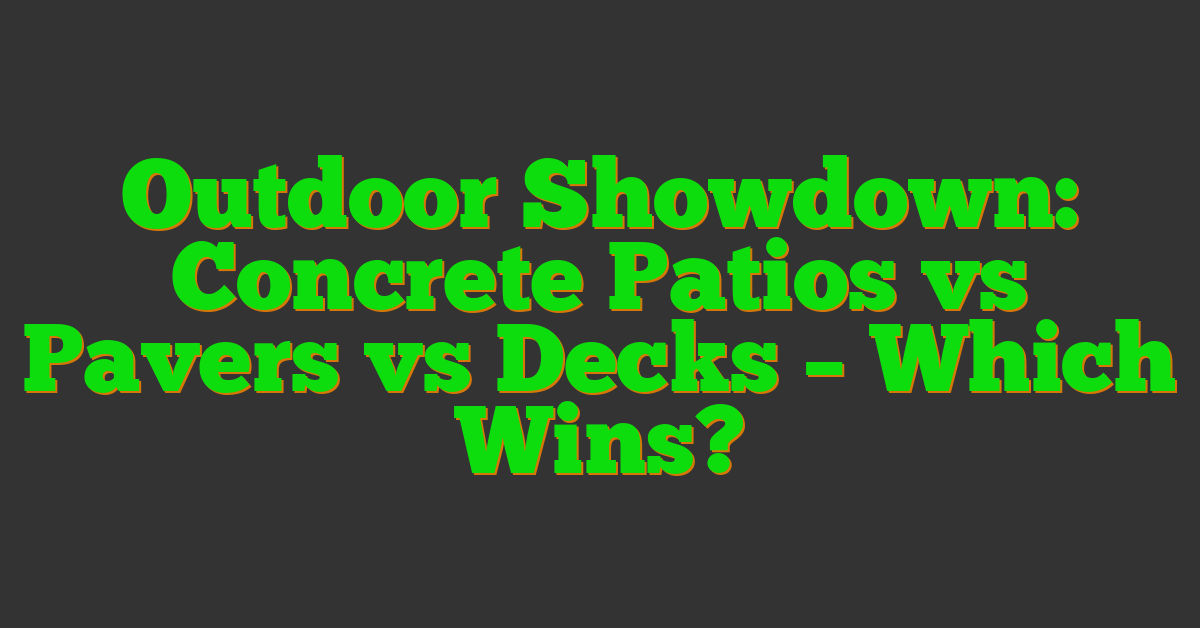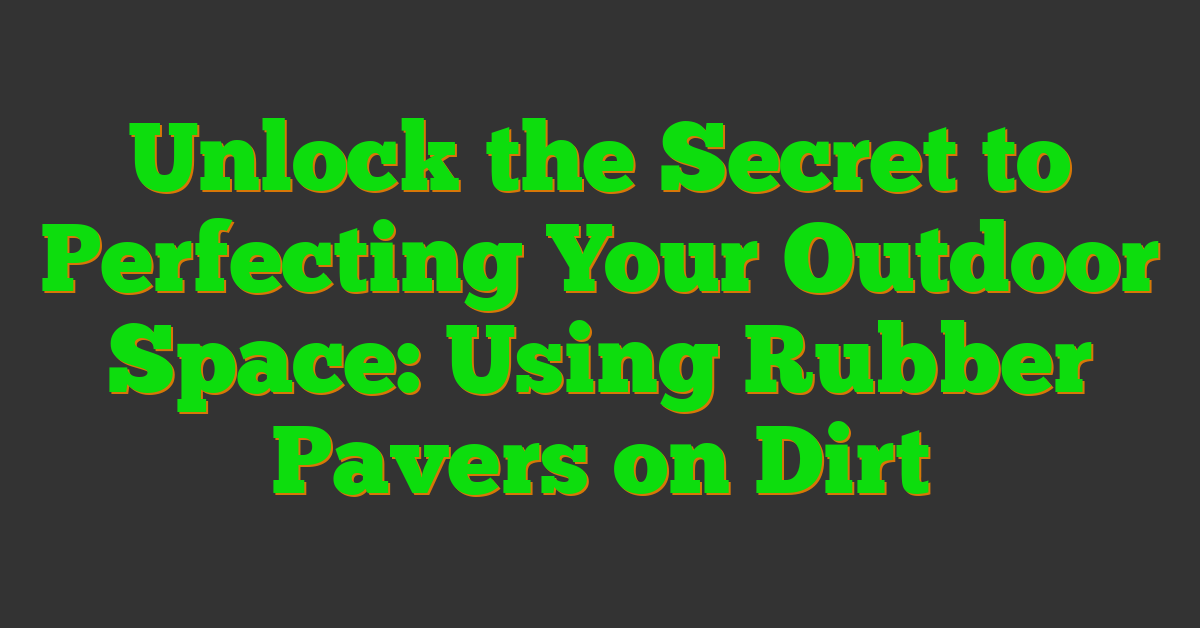Looking to enhance your outdoor space without the hassle of traditional pavers? We’ve got you covered. When it comes to finding the best alternative to pavers for your landscaping projects, it’s essential to explore options that offer both durability and aesthetic appeal.

In this article, we’ll dive into innovative alternatives that can elevate your outdoor areas with style and functionality. From eco-friendly materials to cost-effective solutions, we’ll guide you through some of the top choices that can transform your patio, walkway, or driveway. Let’s discover how you can achieve a stunning look for your outdoor living spaces without compromising on quality.
Understanding Pavers and Their Alternatives
As landscape designers, we know the crucial role that materials play in outdoor spaces. When it comes to traditional pavers, they have long been a go-to choice for patios, walkways, and driveways due to their durability and classic appeal. However, exploring alternatives can open up a world of possibilities for creating unique and stylish outdoor environments. Let’s delve into the pros and cons of traditional pavers, as well as the criteria we consider when selecting alternative options.
Pros and Cons of Traditional Pavers
Traditional pavers are renowned for their ability to withstand heavy foot traffic and varying weather conditions, making them a reliable choice for outdoor surfaces. Their versatility in design offers a range of patterns and colors to suit different aesthetic preferences. Additionally, pavers are relatively easy to install and repair, providing a convenient option for enhancing outdoor areas.
On the flip side, traditional pavers can be costly, especially for larger projects, impacting the overall budget of a landscaping endeavor. Maintenance requirements, such as periodic sealing and potential weed growth between pavers, can also add to the long-term upkeep efforts. Moreover, the uniformity of pavers may limit creativity in design compared to more innovative alternatives.
Criteria for Selecting Alternatives
When considering alternatives to traditional pavers, several criteria guide our selection process to ensure the best outcomes for our clients. We prioritize materials that offer durability comparable to pavers while allowing for enhanced aesthetic appeal and design flexibility. Eco-friendly options that align with sustainable landscaping practices are also a key consideration for us.
Cost-effectiveness remains an important factor, as we aim to deliver value without compromising quality. Ease of installation and maintenance is another criterion we weigh heavily, seeking alternatives that streamline the landscaping process and reduce long-term upkeep costs. By carefully evaluating these criteria, we can recommend innovative alternatives that elevate outdoor spaces with style and functionality.
Reviewing Material Alternatives to Pavers
As landscape designers, we constantly seek innovative alternatives to traditional pavers that can enhance outdoor spaces while balancing durability and aesthetic appeal. Let’s delve into unique options that can elevate your outdoor area with style and functionality.
Concrete: A Versatile Option
Concrete is a go-to material for us due to its versatility and durability. It offers a wide range of design possibilities, from stamped patterns to stained finishes. While concrete can mimic the look of pavers, it provides a more budget-friendly option without compromising on style. Its seamless installation and low maintenance make it a practical choice for various outdoor projects.
Gravel: Affordable and Easy to Install
Gravel is a favorite choice of ours for its affordability and ease of installation. This material adds a rustic charm to outdoor spaces and is perfect for pathways, driveways, and patio areas. The natural texture of gravel blends well with different landscape designs, offering a cost-effective solution for enhancing your outdoor setting. With proper edging, gravel can stay in place and requires minimal upkeep.
Wood Decking: Aesthetically Pleasing and Natural
Wood decking is a classic option that brings warmth and natural beauty to any outdoor area. As landscape designers, we appreciate the aesthetic appeal of wood, which can complement various architectural styles. Whether you opt for hardwood or composite decking, this material offers a cozy and inviting atmosphere. While wood decking may require more maintenance compared to other alternatives, its timeless appeal makes it a popular choice for outdoor living spaces.
Rubber Tiles: Eco-Friendly and Safe
Rubber tiles are a sustainable option that aligns with our eco-conscious approach to landscaping. Made from recycled materials, rubber tiles are not only environmentally friendly but also provide a safe and comfortable surface for outdoor activities. These tiles come in a variety of colors and patterns, allowing for creative design possibilities. With their slip-resistant and shock-absorbent qualities, rubber tiles are ideal for family-friendly outdoor areas.
By exploring these material alternatives to traditional pavers, we can help you transform your outdoor space into a stylish and functional oasis that suits your unique preferences and lifestyle.
Innovative Design Alternatives
Permeable Paving Solutions
When it comes to creating environmentally friendly outdoor spaces, we always consider permeable paving solutions as a top choice. These alternatives allow water to pass through the surface and soak into the ground, reducing runoff and helping the environment. Materials like permeable concrete pavers and porous asphalt offer both functionality and eco-friendliness. They not only enhance the aesthetic appeal of the outdoor area but also contribute to sustainable landscaping practices.
Stamped and Decorative Concrete
In our landscape designs, we often recommend stamped and decorative concrete as an innovative alternative to traditional pavers. Stamped concrete offers a wide range of patterns and textures that can mimic natural stone, brick, or even wood, providing a customizable and stylish look to outdoor spaces. The versatility of decorative concrete allows us to create unique designs that complement the overall theme of the landscape while ensuring durability and ease of maintenance.
Artificial Grass Interlocking Tiles
For clients looking for a low-maintenance and visually appealing option, we suggest artificial grass interlocking tiles. These tiles provide the lush green look of natural grass without the need for extensive upkeep. They are versatile, easy to install, and ideal for transforming dull outdoor areas into vibrant and inviting spaces. Artificial grass interlocking tiles are a great choice for those seeking a cost-effective and sustainable solution for their landscaping needs.
By incorporating these innovative design alternatives into our projects, we can create outdoor spaces that not only meet our clients’ preferences but also contribute to a more sustainable and aesthetically pleasing environment. Our goal is to provide practical and creative solutions that enhance the beauty and functionality of outdoor living areas while promoting eco-friendly practices.
Cost Comparison
Initial Investment vs. Long-Term Value
When comparing the costs between traditional pavers and their alternatives, we always consider the initial investment versus the long-term value that each option brings. While traditional pavers may seem cost-effective initially, they often require more maintenance over time, which can lead to higher long-term expenses. On the other hand, alternative materials like gravel, wood decking, and rubber tiles may have higher upfront costs but offer durability and require less maintenance, translating to cost savings in the long run.
Maintenance and Durability Considerations
In our landscape design projects, we prioritize materials that are not only aesthetically pleasing but also durable and easy to maintain. Traditional pavers, while initially attractive, can be prone to cracks and shifting over time, requiring regular maintenance. In contrast, alternative options such as concrete, gravel, wood decking, and rubber tiles offer better durability and require less upkeep, making them cost-effective choices in the long term. By selecting materials that are durable and low maintenance, we ensure that our outdoor spaces remain beautiful and functional for years to come.
« Techo Bloc vs Unilock: Which Pavers Reign Supreme for Your Outdoor Oasis? Unlock the Secrets to Perfect Outdoor Spaces with Paving Units »
Ecological Impact
As landscape designers, we prioritize the ecological impact of materials when creating outdoor spaces. Choosing sustainable materials not only benefits the environment but also adds value to the overall design. Let’s explore how alternative paving options can positively impact the ecosystem.
Sustainable Materials
When selecting alternatives to traditional pavers, we focus on choosing sustainable materials that are environmentally friendly. Opting for materials like permeable pavers, recycled rubber tiles, or reclaimed wood decking can help reduce environmental impact. These materials often require less energy to produce and contribute to resource conservation.
Reducing Runoff and Promoting Drainage
Another crucial aspect we consider is reducing runoff and promoting proper drainage in outdoor areas. Sustainable paving options, such as permeable pavers and gravel, allow water to filter through the surface and replenish the groundwater. By minimizing runoff, we can prevent water pollution and erosion, creating a more sustainable outdoor environment that benefits both the ecosystem and the overall design aesthetic.
Installation and Maintenance Tips
DIY vs. Professional Installation
When it comes to installing alternative paving materials, the decision between a do-it-yourself (DIY) approach and hiring professionals is crucial. While opting for a DIY project can be cost-effective, it’s essential to consider the complexity of the installation process. We recommend evaluating your skills and the scope of the project before embarking on a DIY path. If you’re confident in your abilities and have the necessary tools, you can save money and enjoy a hands-on experience. However, for intricate designs or large areas, it’s best to enlist the expertise of professional installers. They can ensure proper installation, durability, and a polished finish, saving you time and effort in the long run.
Longevity and Care for Different Materials
Maintaining your alternative paving materials is essential for prolonging their lifespan and preserving their aesthetic appeal. We advise considering the longevity and care requirements of different materials before making a choice. Concrete is durable but may require occasional sealing to prevent stains and cracks. Gravel, while low-maintenance, may need periodic replenishment to retain its appearance. Wood decking demands regular sealing and staining to resist rot and weathering. Rubber tiles are easy to clean but can fade over time, requiring occasional replacement. We suggest researching the specific maintenance needs of each material to ensure they align with your lifestyle and preferences. By understanding the care requirements upfront, you can enjoy a beautiful outdoor space that stands the test of time.
Conclusion
Considering the various alternatives to traditional pavers discussed, we’ve uncovered a world of possibilities for creating durable, visually appealing, eco-friendly, and cost-effective outdoor spaces. By exploring materials like concrete, gravel, wood decking, and rubber tiles, we’ve broadened our options for sustainable paving solutions. It’s essential to prioritize longevity and maintenance to uphold the beauty and functionality of our outdoor areas. Whether opting for DIY installation or seeking professional help, evaluating skills and project complexity is key. Remember, each material requires specific care to ensure its lasting charm. Researching maintenance requirements will guide us in preserving our outdoor spaces for years to come. Let’s embrace these alternative paving options to enhance our surroundings with style and sustainability.















